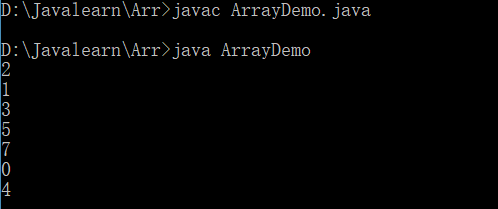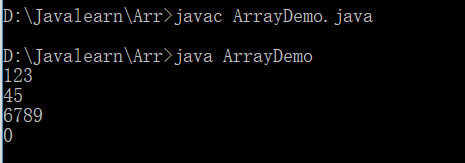1.數組的定義: 第一種: public class ArrayDemo{ public static void main(String[] args){ //定義數組 int [] arr = new int[3]; //數組中的元素預設值為0 System.out.println(arr[0]) ...
1.數組的定義:
第一種:
public class ArrayDemo{
public static void main(String[] args){
//定義數組
int [] arr = new int[3];
//數組中的元素預設值為0
System.out.println(arr[0]);
System.out.println(arr.length);
}
}

這裡的length是數組的長度
第二種定義方法:
public class ArrayDemo{
public static void main(String[ ] args){
//定義數組,註意new後邊的中括弧不能寫數字
int [ ] arr = new int[ ]{1,2,4,3,6,5};
System.out.println(arr[4]);
System.out.println(arr.length);
}
}
第三種(最常用的):
public class ArrayDemo{
public static void main(String[ ] args){
int [ ] arr = {1,2,4,3,6,5};
System.out.println(arr[4]);
System.out.println(arr.length);
}
}
兩種的結果相同,如下:

2.數組的賦值:
arr[1] = 3
3.遍歷
public class ArrayDemo{
public static void main(String[] args){
int [] arr = {2,1,3,5,7,0,4};
for(int i = 0 ; i < arr.length; i++){
System.out.println(arr[i]);
}
}
}
結果:

4.獲取最大值(最小值原理相同):
public class ArrayDemo{
public static void main(String[] args){
int [] arr = {5,-1,2,-4,6,0,8,3};
int max = arr[0];
for(int i = 1 ; i < arr.length; i++){
if( max < arr[i]){
max = arr[i];
}
}
System.out.println(max);
}
}

5.二維數組:
定義:
int [][] arr = new int [3][4];
int [][] arr = {{1,2},{3,4,5},{6,7,8,9}};
記憶體方法:在堆中存三個一維數組,每個一維數組有四個位置,三個一維數組的首地址存入一個新的數組,這個新數組也有首地址,棧中的arr指向這個地址
二維數組訪問和一維數組類似
遍歷:
public class ArrayDemo{
public static void main(String[] args){
int [][] arr = {{1,2,3},{4,5},{6,7,8,9},{0}};
for(int i = 0 ; i < arr.length; i++){
for(int j = 0 ; j<arr[i].length; j++){
System.out.print(arr[i][j]);
}
System.out.println();
}
}
}



